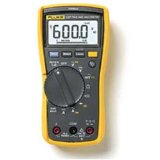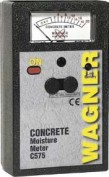

Search This Site
Search With Google
Concrete Floors
Examples Of The Concrete Moisture Meter
Concrete Moisture
Delmhorst Moisture Check-
Drying Concrete Quickly
One issue with concrete and concrete moisture within the construction industry is time scales. More often than not, a construction schedule will not allow necessary drying time for concrete to take place. This can have consequences.
If a flooring is installed over a concrete slab before it has fully dried to sufficient levels the results can be:
Ruined flooring.
An added cost of having to reinstall a new floor.
The interior of the building will be affected by any excess moisture that escapes from the slab.
It could even be an issue with lawyers involved.
So any building project does need to include time within in for concrete drying.
Before any concrete can be dried, it does need to be cured first. Curing is a process which allows a suitable level of moisture to remain in the concrete to perform the hydration process properly. Without the curing process, the surface of the concrete can be ruined and any possible problems in the future, greatly increased. The correct curing process will also result in increased compressive strength and durability of the concrete.
With curing the concrete needs to remain as saturated as possible to allow for 70% hydration. If the concrete is fresh, then it needs to be kept moist for at least the first 5 days of the curing process. To slow down the evaporation process of the concrete one can cover the wet concrete with waterproof paper, a polythene sheet or a burlap.
Moisture Meter Guide
The complete moisture meter website
A home or building that is properly constructed should provide the occupant with a warm, dry and efficient environment to exist in. However, no matter how well a building is constructed, there are always a number of variables that come in to play that can affect this. A poorly constructed building can quickly become a nightmare.
Moisture can be the catalyst to severe deterioration in any building components leading to such symptoms as health problems from mold and even insect infestation. So when a building is built, many aspects need to be taken on board. The building materials used and the site itself need to be thoroughly examined. Any sight needs the assurrance of correct exterior water drainage and any building materials need to be tested to ensure correct moisture levels in them.
Any building includes floor slabs, wall systems and a roofing system, all of which need to be tested for moisture levels to ensure correct levels are there from day one. Failure with this can lead to long term problems and the probability of a very uncomfortable environment to be be in.
Moisture Meter Guide 2010 Contact details:garnett65@hotmail.com
To test the moisture levels of a concrete slab before laying a floor it is always advisable to use a reliable moisture meter and keep detailed records of the results you get.
You should wait for at least 28 days of drying before you perform a moisture meter test on the concrete. Test the concrete at least a week and no more than 6 weeks before you are scheduled to lay the floor.
Moisture Limits
Any excess moisture in a concrete slab can have catastrophic affects on any finished floor. The cost of something that is completely avoidable, runs into millions every year. When a floor is ruined there are costs for labour and materials and of course any down time that is incurred.
Any flooring problems can be the result of:
A failure to survey water sources to a site.
Not using moister retarders under the concrete.
Not using correct mixes of concrete and water.
Not curing the concrete.
Inadequate drying time of the concrete.
Not testing the concrete properly with a moisture meter.
Below is a list of some of the issues you may come up against if you install a finished floor on concrete that has not been dried properly:
Floor adhesive will breakdown.
The coatings will debond.
Osmotic blisters of the epoxy system.
A possible alkali attack on a floor finish.
The floor may well expand, resulting in cupping.
Wagner C575 Concrete Moisture Meter
This moisture meter for testing concrete is a non damaging pin less version. It can
be used to test concrete up to ¾ of an inch in depth. Ideally it should be used for
qualitative quick scans. Features include an analog display, measuring scale of 0
-
Pin less Moisture Meter
Relative readings for concrete
Analog Display
Measurement Scale -
Depth of measurement-
Non-
Here we have a moisture meter that is dual action. It can operate in a pin mode or on scan mode. So if you want a concrete moisture meter this is a very good instrument to own. You also have the capability to test wood with it as well. Versatility is the name of the game!
LCD display
Corrects for 69 wood species
Stated wood moisture range: 5% -
Pin Mode (Invasive) measuring depth: 5/16"
RF Mode (Non Invasive) measuring depth: 3/4"
Datalogging Feature stores up to 1400 stored readings
Connector for optional external electrodes
When choosing a floor slab one has to consider the stability of soil, sub base levels and compaction before laying them. Also the weight and traffic numbers that will pass over the slab. Only after all these considerations have been evaluated can a suitable vapor barrier be installed underneath the floor slab and then the concrete poured. Pretty simple process really? But not so!!!
The problem is that when cement is combined with water the hydration process begins immediately. The amount of water required for the cement to hydrate properly is different to the amount of water that is required for finishing. That means that the issue of free water has to be attended to and evaporated off before any finished floor product can be installed. To summise, a lot of water needs to be evaporated and any additional moisture which affects the slab from wet curing, rain and relative humidity, also needs to be evaporated off.
The best way to start the drying process of a concrete slab is to protect it from any further moisture invasion. So placing the slab in an environment that allows water evaporation to take place without adding any further moisture, is essential. When laying the concrete floor, it needs to be done in an airtight and water tight environment.
It is possible to achieve a quicker drying and curing process for concrete. For this one must have:
Suitable drainage around and underneath the building.
Use a capillary break
Install a suitable vapour retarder under the concrete.
Make sure you use a well engineered mix of concrete.
A concrete slab drying time can be different for each one. The industry recommended time scale is about 1 month drying time for every inch of concrete slab. But there are other factors which can manipulate that time scale. They are:
Amount of water used.
The type of aggregate in the concrete.
Humidity and temperature of the location.
Wind
The type of vapour retarder used.
There is dehumification equipment available which can be used in the drying process. Indeed many of these examples of equipment have been specially designed with the construction industry in mind.
And to test and see if the concrete is sufficiently dry, one can test it and obtain an accurate reading with a suitable moisture meter, or a specific concrete moisture meter.
Installing Finished Flooring


Construction Issues
To Care Is To Share
| Tramex Moisture Encounter Plus |
| Tramex Compact Wood Moisture Meter |
| Tramex Concrete Encounter Moisture Meter |
| Tramex Skipper Plus Moisture Meter |
| Tramex Roof And Wall Moisture Scanner |
| Sonin Digital Moisture Meter model 50218 |
| Sonin Digital Moisture Meter 270 model 50270 |
| Sonin Moisture Test Tool model 50210 |
| Sonin Moisture Test Meter Model 50211 |
| Oak |
| Douglas Fir |
| Beech Tree |
| Elm Tree |
| Hickory Tree |
| Maple Tree |
| Pine Tree |
| Prevent And Repair Gaps In Wooden Floorboards |
| How To Fix A Squeaky Hardwood Floor |
| How To Repair A Hardwood Floor That Has Buckled |
| Which Is The Best Firewood? |
| Concrete |
| Concrete Moisture |
| Screed Moisture Meter |
| SDS Drill |
| Belle Cement Mixer |
| SDS Drill Advice |
| Which SDS Drill |
| SDS Drill Accessories |
| Drilling Into Concrete |
| Kennedy Tool Box |
| Moisture - Basic Facts |
| Types Of Damp |
| Wet Rot |
| Dry Rot |
| Mold |
| Water Leak Detection |
| Stucco Moisture |
| Water Damage |
| Moisture And Rust |
| Moisture Damage To A Chimney |
| Wallpaper Stripper |
| Plaster Mixer |
| Why Worry About Moisture Problems |
| Does Your Home Have A Moisture Problem? |
| How To Solve Moisture Problems |
| How To Use Anti Mold Paint |
| Rising Damp |
| Condensation |
| Salt Damp |
| How To Avoid Bathroom Condensation |
| How To Remove Black Mold |
| How To Prevent Bathroom Mold |
| Soldering Kit |
| Soldering Kit Contents |
| Soldering Kit Advice |
| Bonsai Tree Classification |
| Growing Bonsai From Seed |
| Bonsai Tree Care |
| Bonsai Tree Training |
| Bonsai Tools |
| Displaying Bonsai |
| Bonsai Calendar |
| Bonsai Plants |
| The Thirsty Light Curve Moisture Meter |
| The Thirsty Light Ladybird Moisture Meter |
| The Thirsty Light Bumble Bee Moisture Meter |
| The Thirsty Light Butterfly Moisture Meter |
| Hanna Instruments |
| Agratronix Portable Coffee Moisture Tester |
| Lawn Aerator |
| Lawn Roller |
| Lawn Rake |
| Lawn Sand |
| Chainshot |
| Chainsaw Gloves |
| Chainsaw Trousers |
| Chainsaw Boots |
| Mac 4 - 20 XT Chainsaw |
| Mac 738 Chainsaw |
| Mac 842 Chainsaw |
| Mac 20X Power Chainsaw |
| Einhell BG-PC 3735 Chainsaw |
| Einhell BG-PC 4040 Chainsaw |
| Einhell BG-PC 5045 Chainsaw |
| Poulan P3314 Chainsaw |
| Poulan P4018 Chainsaw |
| Poulan Pro PP3816AV Chainsaw |
| Poulan Pro PP4218AVX Chainsaw |
| Poulan Pro PP4620AVX Chainsaw |
| Efco MT 4100 SP Chainsaw |
| Efco MT 3500 Chainsaw |
| Efco 132 S Chainsaw |
| Efco 147 Chainsaw |
| Efco 152 Chainsaw |
| Efco MT 7200 Chainsaw |
| Efco MT 8200 Chainsaw |
| Efco MT 3750 Chainsaw |
| Methods Of Obtaining Soil Moisture Levels |
| Hygrometer |
| Psychrometer |
| Rain Gauge |
| Wave Ventilation System |
| Humidity |
| Hygrometer For Keeping Reptiles |
| Humidor |
| Weather Stations |
| Musical Instrument Storage |